A former salami factory in east Rome is a refuge for squatting migrants as well as being a precarious cathedral of street art.
Outside the museum an earthen path skirts a dangerous stretch of road – Via Prenestina – where motorists jostle for access to the multinational sports store opposite. The area's bins have not been emptied for some time, a reminder of the forgotten nature of Tor Sapienza, a marginalised suburb in Rome's eastern-most city limits.
This dispiriting urban sprawl of flats, flyovers and factories normally makes the news for the wrong reasons. In November 2014 Pope Francis warned of a "social emergency" after sustained protests outside a local immigration centre stoked tensions between Romans and migrants.
Two years later a 20-year-old Chinese student was killed after being struck by a train as she pursued her muggers, three young men from the Roma camp on Via Salviati, near the Tor Sapienza immigration office.
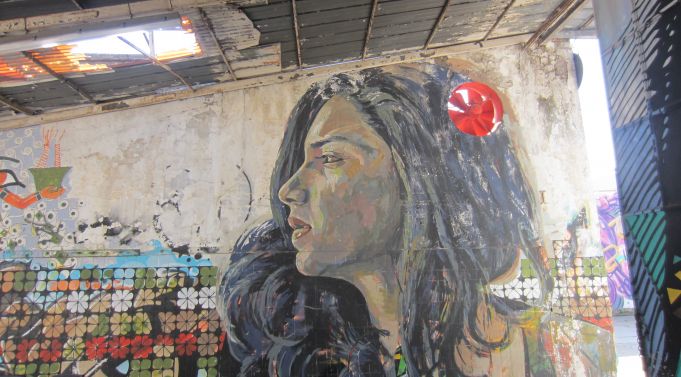
On 5 July the embattled district made headlines in the Italian art world as well as the national newspapers, thanks to a ruling by the civil courts in Rome. Italy's interior ministry was fined €27.9 million over the Fiorucci site, an illegally-occupied former salami factory turned street art museum, known as Museo dell'Altro e dell'Altrove di Metropoliz_città meticcia, or MAAM for short.
The state was ordered to pay the massive sum to the owners of the property, the powerful international construction firm Salini. The court also ordered the eviction of the 200 squatters from the site and condemned the "tolerance of illegal occupation" in Rome, citing the existence of around 100 other similar cases in the capital.
Evictions
On the same day as the MAAM ruling, police evicted 100 Sudanese migrants, mostly working as hawkers and harvesters, from another building on Via Scorticabove in the neighbouring S. Basilio district. In March hundreds of migrants were removed from privately-owned property on Via di Vannina, also in S. Basilio, just north of MAAM. Many have taken shelter in a former penicillin factory on nearby Via Tiburtina, where around 600 people live in appalling conditions, some in shacks constructed from asbestos panels.
The case of MAAM has also reignited the divisive debates – separate but interconnected – of social housing and asylum seekers, in a city suffering from a chronic public housing shortage.
Bureaucracy
The Fiorucci factory, which now houses MAAM, ceased to operate in the mid-1980s. It was purchased by Salini in 2003 for €6.85 million. The firm intended to transform the 19,000-sqm site into apartment accommodation, part of which would become social housing, with the city's approval. However the plan became mired in bureaucracy for ten years, only receiving the green light in 2013.
By this stage the Fiorucci site had been occupied illegally for four years, thanks to the efforts of the Blocchi Precari Metropolitani (BPM). This collective of Rome activists involved in “property reappropriation” has sourced accommodation for migrants from South America, north Africa and eastern Europe.
Peaceful coexistence
The 200 current occupants, including 60 children, live in peaceful coexistence. Their multiethnicity is reflected in the surnames painted on the constellation of post boxes, almost an art installation in itself, as well as the compound's various place names such as Corridoio dei rom or Piazza Perù.
In 2012 the sprawling site took an experimental artistic direction, assuming the name MAAM, and today is home to more than 500 works of urban art, from murals to installations.
Its exterior wall boasts an eye-catching but fading portrait of the Pakistani activist for female education, Malala Yousafzai, by Brazil's Eduardo Kobra. This is flanked by more sober figurative works by street art giants, Rome-based duo Sten & Lex and Borondo from Spain.
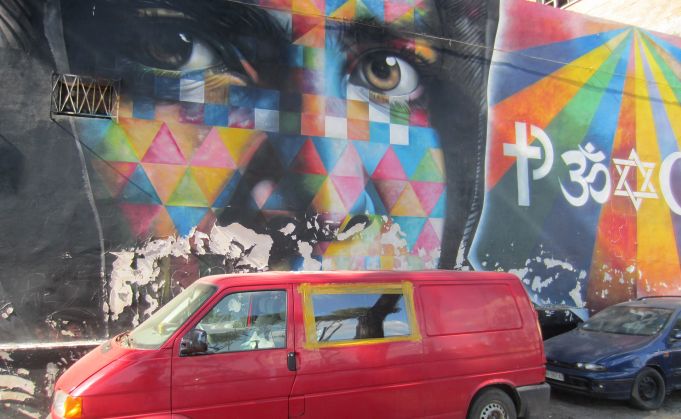
Above the former reception area, the old Fiorucci factory sign has been adapted to read “FART”, poking fun at self-important art institutions. Even the acronym MAAM appears to be a gentle dig at the capital's contemporary art centres MAXXI and MACRO.
Three days after the shock court order, it is business as usual at MAAM. Inside the gates an elderly Eritrean lady points to a wooden box suggesting a €2 donation for the museum. It is a Saturday, open day, and visitors marvel at the art in the corrugated halls and stairways, the roofless rooms and dark corners.
Artist who's-who
The murals are punchy, sometimes disquieting, and invariably carry a social, political or environmental message. Since the project began in 2012 the walls have become a who's-who of the contemporary art world, from senior figures such as Pablo Echaurren to younger street artists including Lucamaleonte, Alice Pasquini andGiò Pistone (all of whose work has featured on Wanted in Rome covers).
MAAM's rusting hooks and curing tanks – a macabre reminder of its grisly origins – are referenced in the pig production-line mural La cappella porcina – eMAAMcipazione, by Spain's Pablo Mesa Capella and Gonzalo Orquín.
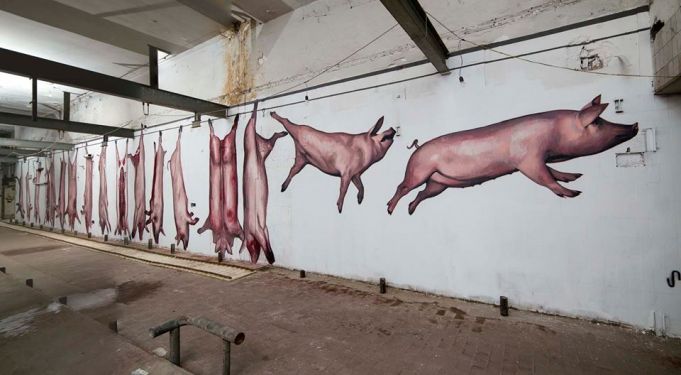
The heart of this fascinating complex is a large canteen where a mid-afternoon meeting is underway between residents and activists. In their midst sits the museum's founder Giorgio de Finis, an independent curator, documentary filmmaker and respected figure in street art circles. He is the man responsible for encouraging more than 300 artists to donate their work as a form of “barricade” to defend the occupied premises.
After the meeting a man belts out a joyful tune on a battered piano to the delight of a baby chuckling in its mother's arms. As de Finis departs with his entourage he pauses in a corridor to encourage an artist as she creates a sign saying Incontro (Meet) with coloured wool, watched by a lean cat.
The next morning de Finis was among activists, artists and journalists who boarded two buses as part of the R/home Tour highlighting the plight of people living in “occupied” buildings around the city. In a highly unusual move, the tour was attended by the city's deputy mayor with responsibility for culture, Luca Bergamo, a member of the populist Movimento 5 Stelle and old school friend of de Finis.
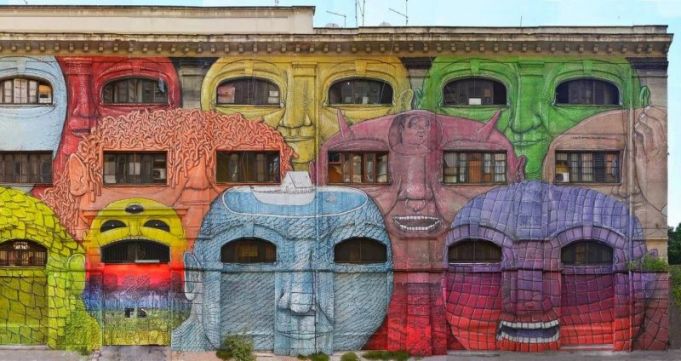
The first stop on the tour, organised by housing rights associations, was the Ex Caserma on Via del Porto Fluviale in Ostiense. Here too street art is intertwined with the occupied movement. The vast façade was painted by celebrated Bolognese street artist BLU while he squatted among the residents for two years. Today the building is occupied by around 60, mainly foreign, families as well as some down-on-their-luck Italians. Many tell a similar tale of redundancy, rent arrears and eviction.
Socio-cultural success
The tour ended at MAAM which despite its denigratory label as a “museo abusivo” is considered a socio-cultural success by its supporters. MAAM first welcomed Bergamo in his official capacity as culture councillor in October 2016 – two months before he became deputy mayor.
During that visit Bergamo held up the unauthorised museum as a cultural model for Roman contemporary art. Two years later he remains a cheerleader of the project despite the M5S-led city government's hard line approach to evictions.
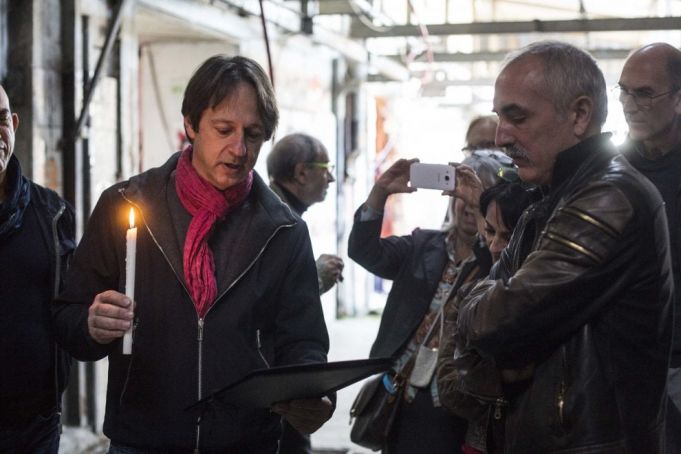
On 19 July Bergamo and de Finis presented a high-profile cultural initiative involving a municipal museum and €400,000 in city funding. De Finis was Bergamo's controversial choice as curator of an experimental project known as Asilo (Asylum) at MACRO, the Museo d'Arte Contemporanea on Via Nizza, to run from 1 October until the end of next year.
Bergamo clarified that de Finis would be the "curator" of the project, not the director of MACRO, bypassing the requirement of a public tender process. However given the fact that Asilo will be MACRO's sole activity for 15 months, de Finis is viewed as the museum's de facto director.
MACRO Asilo
De Finis plans to transform MACRO, which has been without a director or direction for more than two years, into a “living” museum, granting contemporary artists the space to work, perform and interact with the public who can visit for free. It remains to be seen whether such a subversive figure, who plans to draw on his “anti-institutional experience”, can win over a mistrusting art establishment or whether his appointment will ultimately prove damaging to Bergamo and the M5S.
As preparations gather pace for the Asilo opening party on 30 September, the future has never been more precarious for the residents of MAAM who, despite their diverse backgrounds, share their illegal lodgings in harmony amid a treasure trove of world-class street art.
By Andy Devane
MAAM, on Via Prenestina 913, can be visited (for now) on Saturdays only, from 10.00-17.00. It can be reached by taking the 508 bus from Ponte Mammolo metro station for 14 stops, getting off at Prenestina-Tiratelli. MACRO Asilo on Via Nizza 138 can be visited for free from 1 Oct 2018 until 31 Dec 2019 on Tues, Wed, Thurs, Fri and Sun 10.00-20.00. Sat 10.00-22.00. Mon closed.
This article was published in the September 2018 edition of Wanted in Rome magazine.
General Info
View on Map
MAAM street art museum in Rome: migrants, murals and marching orders
Via Prenestina, 913, 00155 Roma RM, Italy

















